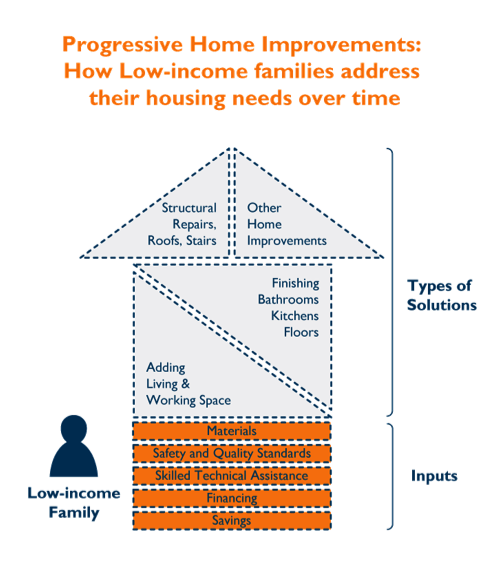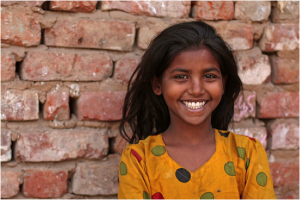Housing Series: Strategies to Add Quality and Value to Incremental Home Improvement
Editor’s Note: NextBillion has launched month-long series on Housing for All in partnership with Ashoka. This special series coincides with two upcoming Ashoka publications on best strategies to achieve Housing for All, Ashoka’s initiatives using its Hybrid Value Chain framework to leverage changes in the affordable housing sector in Brazil, Colombia and India. Please follow the series HERE and Join the discussion with your thoughts and insights.
The current low-income housing market is estimated at US$ 424 billion.[1] If the inefficiencies and barriers I described in part one of this two-part article were overcome – imagine how resolving unsafe living conditions for hundreds of millions could be accelerated? Further imagine doing so in ways that create profits for companies in BoP markets, while allowing government to focus its efforts on the poorest segment (who may not even be able even to self build), and on improving the urban public infrastructure, building safety standards and public services.
Various stakeholders are working together with BoP communities to innovate new, inclusive and market-driven strategies to raise quality, lower costs and time, add technical assistance, obtain land tenure and title, and do so within legal and commercial frameworks that leave citizens not only with a sturdier roof overhead, but with increased confidence, skills and a good credit track record to build on for the future.
If implemented more widely, these strategies can add value to the “incremental improvement” head start that citizens now have and enable them to cross the finish line faster, cheaper, better and more safely. Here are some of the best standout examples:
1. Increase the incentives to home improvement loans for longer repayment periods at competitive interest rates.
CEMEX, through its Patrimonio Hoy program, for example, learned that its low-income clients needed not cheaper cement, but integrated solutions, such as materials for a new bathroom or an entirely new room. As a result, Patrimonio Hoy offers CEMEX cement bags along with products manufactured by other companies – through leveraging distributor relationships – for which Patrimonio Hoy receives a margin of the sale price. This integrated offering, of not just cement, but everything required for the desired home improvement including financing, is a huge time and cost savings for a family. Families are able to implement home improvements in one-third of the time it would normally take, and at 33 percent lower costs. Ten years in, Patrimonio Hoy is a profitable business unit of CEMEX. [2]
In Colombia, new government housing, finance and economic policies have increased the diversity and quantity of financial products and services for longer-term (up to five years) home improvement loans to those who earn above 1.5 to 2 times the minimum salary. The increase in competition has lowered rates and created interest in finding good matches between clients and the right services – a far cry from the scarcity of options and inadequate capital just five years ago.

2. Bundle technical assistance along with finance to increase the quality, and decrease the costs and time to self-build.
The most ambitious and forward thinking finance providers are partnering with citizen organizations to infuse skilled technical assistance at key points in the building process. They are effectively financing the cost of architects, technicians or contractors who provide construction guidance to BoP families in conjunction with financing the purchase of materials for a home improvement. Organizations such as Reforma Mais in Brazil, in partnership with Banco do Nordeste,microHome Solutions, in partnership with BASIX, a micro financeinstitution in India, and Alianza por Vivienda Digna, in partnership with Corona (a tile manufacturer and financer of home improvement projects) in Colombia, lead the way in these efforts.
3. Companies, NGOs and governments design streamlined, fair and peaceful resolution of land title conflicts for privately owned or public lands to give title to homeowners.
Unless title is transferred legally to homeowners, they will never receive the full benefits of loans to build safer, better homes or build a track record of credit-worthiness to get out of slums altogether. The Community Organizations Development Institute’s Baan Mankong program, affiliated with the Thai government, lends money for home improvements to organized groups of slum dwellers. As slum dwellers acquire financing in groups, they can negotiate a long-term lease or purchase their plots of land. This process often results in the transfer of title and ownership of property to slum dwellers, which then triggers the provision of infrastructure and public utilities from the Thai government.[3]
Social businesses such as Terra Nova in Brazil have developed improved, cheaper, and less bureaucratic processes to enable illegal slum dwellers to negotiate with land owners to purchase their plots more quickly. The purchase includes financing over a period that the family can afford, so they then pay landowners outright for title, an incentive for lowering the asking cost of the land, since without negotiation and resolution, the owner might risk losing the total value of the land and be willing to compromise on a reasonable price which, with financing, the homeowner can pay. Once they become owners of the land, Terra Nova reports that residents improve their homes even more than before. The resulting process, sanctioned by local governments, ensures that infrastructure and utilities are extended to previously off-the-grid areas. [4]
4. Develop standards for home improvements to ensure structural integrity, earthquake or flood resistant materials and designs – that are enforced by local governments and provide incentives their use.
The world recently saw the difference in death and injury resulting from housing codes and enforcement when severe earthquakes hit Haiti and Chile in the same year. While destruction abounded in both places, the difference in the loss of human life was directly related to Chile’s better and implemented building standards, versus the informal and unenforced situation in Haiti. The trick, of course, is to have standards strong enough to guarantee safety, while not so costly as to make building affordable housing impossible for the BoP.
Nascent attempts are emerging, pushed by the citizen sector. Elizabeth Hausler’s organization, Build Change, has numerous examples of how local, renewable and inexpensive materials, together with self-build practices and local cultural and aesthetic features, can ensure that affordable, self-built housing carries sound engineering and innovative methods to retain local style but be built to high safety standards.[5]

With over 70 percent of low-income households now addressing their housing needs incrementally, any affordable housing strategy that doesn’t attempt to incorporate self-construction practices and harness these energies is shortsighted, risks missing out on significant and growing market share, and fails to leverage the best head start we have in the race for affordable housing for all.
(Above: A girl in slum at Gulbai Tekra, Ahmedabad. Photo: Meena Kadri, Random Specific).
________________________
[1] This estimate of current market size, appearing A New Alliance for Global Change, in the September 2010 issue of Harvard Business Review (Drayton & Budinich, 2010) is a revised projection of actual low-income housing market size appearing in The Next 4 Billion: Market Size and Business Strategy at the Base of the Pyramid, by World Resources Institute and IFC (Hammond et al., 2007) (using data normalized in 2004). The current 424bn estimate was derived by updating the NB4 market data to reflect inflation for the years 2005-2010.
[2] For more information about Patrimonio Hoy’s innovations linking finance to home improvements and increased revenues, see the soon to be published report, Access to Affordable Housing by Sadna Samaranayake et al., co-published by Ashoka and Hystra. To obtain copies, contact ahughes@ashoka.org and request hard or electronic versions of the report.
[3] See http://www.codi.or.th/housing/aboutBaanmankong.html for more information.
[4] See article and video in this Next Billion Affordable Housing series by Andre Albuquerque, “Rights to the Land Under Your Home,” and a longer case study about their work included in Access to Affordable Housing by Sadna Samaranayake et al. soon to be available from Ashoka. Contact ahughes@ashoka.org to order a free copy.
[5] Visit www.buildchange.org and look for an article describing its work soon to be posted in this series on NextBillion.net
- Categories
- Uncategorized
- Tags
- housing
